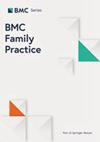Tailoring remote patient management in cardiovascular risk management for healthcare professionals using panel management: a qualitative study
IF 3.2
3区 医学
Q1 MEDICINE, GENERAL & INTERNAL
引用次数: 0
Abstract
While remote patient management (RPM) has the potential to assist in achieving treatment targets for cardiovascular risk factors in primary care, its effectiveness may vary among different patient subgroups. Panel management, which involves proactive care for specific patient risk groups, could offer a promising approach to tailor RPM to these groups. This study aims to (i) assess the perception of healthcare professionals and other stakeholders regarding the adoption and (ii) identify the barriers and facilitators for successfully implementing such a panel management approach. In total, nineteen semi-structured interviews and two focus groups were conducted in the Netherlands. Three authors reviewed the audited transcripts. The Consolidated Framework for Implementation Strategies (CFIR) domains were used for the thematic analysis. A total of 24 participants (GPs, nurses, health insurers, project managers, and IT consultants) participated. Overall, a panel management approach to RPM in primary care was considered valuable by various stakeholders. Implementation barriers encompassed concerns about missing necessary risk factors for patient stratification, additional clinical and technical tasks for nurses, and reimbursement agreements. Facilitators included tailoring consultation frequency and early detection of at-risk patients, an implementation manager accountable for supervising project procedures and establishing agreements on assessing implementation metrics, and ambassador roles. Panel management could enhance proactive care and accurately identify which patients could benefit most from RPM to mitigate CVD risk. For successful implementation, we recommend having clear agreements on technical support, financial infrastructure and the criteria for measuring evaluation outcomes.利用面板管理为医护人员量身定制心血管风险管理中的远程患者管理:一项定性研究
虽然远程患者管理(RPM)有可能帮助基层医疗机构实现心血管风险因素的治疗目标,但其有效性在不同的患者亚群中可能会有所不同。小组管理涉及对特定患者风险群体的主动护理,可为针对这些群体的远程患者管理提供一种有前景的方法。本研究旨在(i)评估医护人员和其他利益相关者对采用这种方法的看法,(ii)确定成功实施这种小组管理方法的障碍和促进因素。在荷兰共进行了 19 次半结构式访谈和两次焦点小组讨论。三位作者审阅了经审核的笔录。主题分析采用了实施策略综合框架(CFIR)的各个领域。共有 24 名参与者(全科医生、护士、医疗保险公司、项目经理和 IT 顾问)参加了此次活动。总体而言,各利益相关方都认为在初级保健中采用小组管理方法进行 RPM 是有价值的。实施障碍包括担心遗漏对患者进行分层的必要风险因素、护士的额外临床和技术任务以及报销协议。促进因素包括调整会诊频率和早期发现高危患者,由实施经理负责监督项目程序并就评估实施指标和大使角色达成一致。小组管理可以加强前瞻性护理,并准确确定哪些患者可以从 RPM 中获益最多,从而降低心血管疾病风险。为了成功实施,我们建议就技术支持、财务基础设施和评估结果的衡量标准达成明确的协议。
本文章由计算机程序翻译,如有差异,请以英文原文为准。
求助全文
约1分钟内获得全文
求助全文
来源期刊

BMC Family Practice
医学-医学:内科
CiteScore
3.20
自引率
0.00%
发文量
0
审稿时长
4-8 weeks
期刊介绍:
BMC Family Practice is an open access, peer-reviewed journal that considers articles on all aspects of primary health care research. The journal has a special focus on clinical decision making and management, continuing professional education, service utilization, needs and demand, and the organization and delivery of primary care and care in the community.
 求助内容:
求助内容: 应助结果提醒方式:
应助结果提醒方式:


